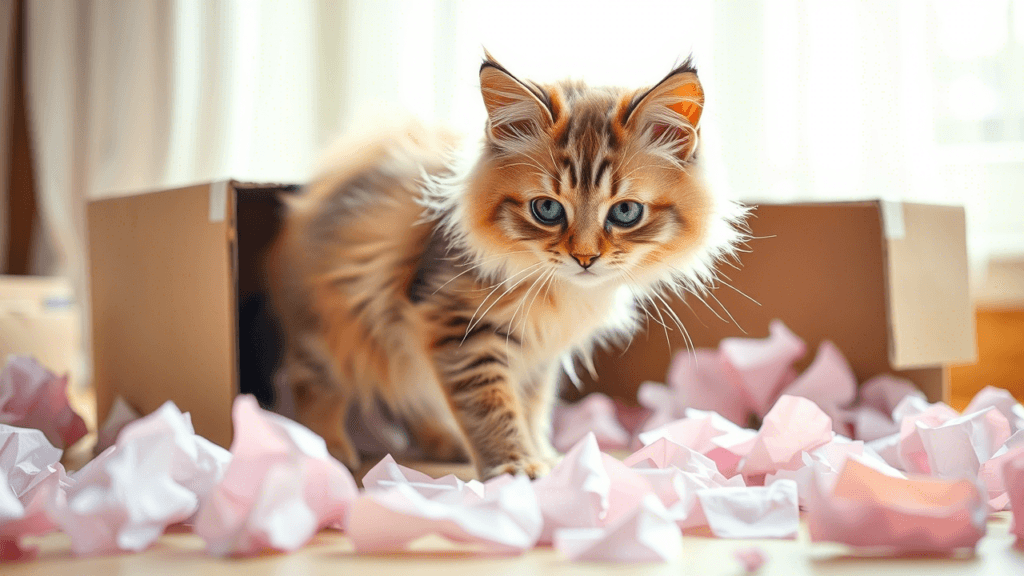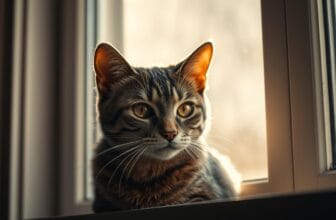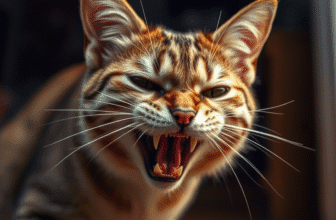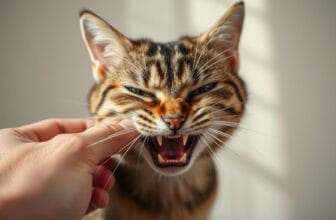
Table of Contents
If you’ve ever brought home a new appliance or received a package in the mail, you’ve likely witnessed a curious phenomenon: your cat’s immediate and intense attraction to the empty box. This universal feline behavior has spawned countless viral videos, memes, and bemused observations from cat owners worldwide. But what exactly drives this box-loving behavior? Why do cats like boxes so much that they’ll often choose a cardboard container over an expensive cat bed?
This seemingly simple question actually has fascinating answers rooted in feline psychology, evolutionary biology, and your cat’s unique sensory experience. Understanding why cats like boxes can provide valuable insights into your pet’s behavior and help you create a more enriching environment for them. In this comprehensive guide, we’ll explore the science behind this cardboard fascination and how you can use this knowledge to enhance your cat’s wellbeing.
The Security Factor: Boxes as Safe Spaces

The Predator Who Needs Protection
Despite their status as predators, cats are also prey animals in the wild. This dual identity shapes much of their behavior, including their love for enclosed spaces like boxes.
“Cats are both predator and prey in natural settings,” explains Dr. Claudia Vinke, a veterinary behaviorist at Utrecht University who has studied stress in shelter cats. “Enclosed spaces provide strategic advantages for both hunting and hiding.”
When a cat climbs into a box, they’re activating deep-seated instincts that have evolved over thousands of years. The walls of a box provide:
- Protection from ambush: Nothing can sneak up on a cat when they’re in a box with solid sides
- Stress reduction: Studies have shown that cats with access to hiding boxes have lower stress hormones
- A secure vantage point: Cats can observe their surroundings while remaining relatively hidden
The Stress-Reducing Power of Boxes
In a groundbreaking 2014 study published in Applied Animal Behaviour Science, researchers found that newly arrived shelter cats who were provided with boxes adapted to their new environment more quickly and showed fewer signs of stress than those without boxes.
The cats with boxes had significantly lower stress scores after just a few days, demonstrating that something as simple as a cardboard box can have a profound effect on a cat’s psychological wellbeing. This is particularly important for cats in new or changing environments, but even cats in stable homes benefit from having secure hiding places.
Temperature Regulation: The Comfort Zone
Cats’ Higher Body Temperature Needs
Another key reason cats seek out boxes relates to temperature regulation. Domestic cats generally prefer ambient temperatures between 86-97°F (30-36°C), which is significantly warmer than the average home temperature that humans find comfortable.
“Cats have a higher thermoneutral zone than humans,” notes Dr. Danielle Bernal, veterinarian and pet nutrition specialist. “This means they need less energy to maintain their body temperature in warmer environments.”
Cardboard serves as an excellent insulator, helping cats conserve body heat. When your cat curls up in a box, they’re creating a microclimate that can be several degrees warmer than the surrounding environment. This explains why you might notice your cat seeking out boxes more frequently during colder months.
The Insulating Properties of Cardboard
Cardboard boxes provide several thermal benefits:
- Insulation: The air pockets in corrugated cardboard trap heat effectively
- Reduced heat loss: The enclosed space minimizes heat escaping from the cat’s body
- Comfortable surface: Cardboard maintains a more consistent temperature than many floor surfaces
For cats, finding the perfect temperature spot is instinctual. In the wild, maintaining optimal body temperature without expending excessive energy is crucial for survival. Your domesticated cat is simply following these same instincts when they seek out the cozy confines of a cardboard box.
The Hunting Connection: Boxes as Ambush Sites

Perfect Position for Pouncing
To understand a cat’s attraction to boxes, we need to consider their natural hunting style. Unlike pack hunters that chase down prey over long distances, cats are ambush predators. They prefer to wait patiently and then launch a sudden, powerful attack.
“A box provides the perfect setup for a cat’s preferred hunting strategy,” explains Dr. John Bradshaw, anthrozoologist and author of “Cat Sense.” “It offers concealment with the ability to quickly spring into action.”
When your cat sits in a box, they’re essentially recreating an ideal hunting scenario:
- Concealment: The box hides most of their body from potential “prey”
- Limited entry points: The cat can focus on monitoring a specific area
- Surprise advantage: The elevated position and protection allow for unexpected pounces
Play Behavior and Predatory Instincts
Even well-fed domestic cats retain strong hunting instincts. When your cat leaps from a box to “attack” a toy or perhaps your unsuspecting ankle, they’re engaging in play behavior that mimics hunting sequences.
This play is crucial for cats’ mental and physical wellbeing. The box provides a base for this play, allowing them to practice stalking, pouncing, and capturing “prey” in a way that satisfies their natural instincts.
Sensory Appeal: The Tactile Experience of Boxes

Texture and Material Preferences
Cats have highly developed tactile senses, particularly through their whiskers (vibrissae) and the sensitive pads on their paws. Cardboard offers an interesting sensory experience that many cats find appealing.
“Cats’ paw pads contain numerous nerve receptors that make them extremely sensitive to texture, pressure, and vibration,” says Dr. Gary Landsberg, a veterinary behaviorist. “Different surfaces provide different sensory experiences.”
Cardboard’s specific attributes make it particularly attractive:
- Texture: The slightly rough surface provides tactile stimulation
- Scratching potential: Cats can easily sink their claws into cardboard
- Sound: The crinkly noise when clawed or bitten is stimulating
- Smell: Cardboard has a distinct scent that cats may find interesting
The Importance of Scent and Territory
Cats use scent to mark their territory and create a sense of security. When a cat rubs against a box, scratches it, or simply sits in it, they’re depositing their scent and claiming the space as their own.
This scent-marking behavior helps explain why cats often prefer boxes that already have their scent on them and why they might be particularly attracted to new boxes that can be freshly claimed.
The Psychological Benefits: Boxes and Mental Wellbeing
Stress Reduction and Anxiety Management
Modern home environments can be stressful for cats. Loud noises, unpredictable movements, and the presence of other animals can all trigger anxiety in sensitive cats. Boxes provide a simple yet effective stress management tool.
“The confined space of a box creates a sense of psychological security,” explains Dr. Nicholas Dodman, professor emeritus at Tufts University’s Cummings School of Veterinary Medicine. “It’s similar to how weighted blankets work for humans with anxiety.”
Research has consistently shown that providing hiding spaces like boxes can significantly reduce stress-related behaviors in cats, including:
- Excessive grooming
- Inappropriate elimination
- Aggression
- Withdrawal or hypervigilance
Boxes as Environmental Enrichment
Environmental enrichment is crucial for indoor cats, who may otherwise lack stimulation. Boxes provide a simple form of enrichment that addresses multiple feline needs simultaneously.
“Environmental enrichment isn’t just about toys,” notes certified cat behaviorist Jackson Galaxy. “It’s about creating spaces that satisfy territorial, hunting, and security needs.”
Boxes can be incorporated into enrichment strategies by:
- Creating vertical territory: Stacking boxes at different heights
- Providing novelty: Introducing new boxes periodically
- Encouraging exploration: Cutting holes in boxes to create tunnels and hideaways
- Supporting play: Using boxes as part of interactive play sessions
Practical Applications: Using Box Attraction to Benefit Your Cat

Helping Cats Adapt to New Environments
The stress-reducing properties of boxes make them particularly valuable when cats face changes in their environment. Consider providing boxes during:
- Moving to a new home
- Introduction of new pets or family members
- Renovations or other disruptions to routine
- Visits to unfamiliar places like veterinary clinics or boarding facilities
Simply placing a box in a quiet corner gives your cat a safe retreat where they can observe and gradually adjust to new circumstances at their own pace.
Enrichment Ideas Using Boxes
You can enhance your cat’s environment using their natural attraction to boxes:
- DIY puzzle feeders: Cut holes in boxes and hide treats inside
- Multi-level play stations: Connect several boxes with holes for exploration
- Rotation system: Swap out boxes regularly to maintain interest
- Scent enrichment: Place herbs like catnip or silver vine in boxes
- Thermal retreats: Place a self-heating pad in a box during cold weather
When Box Obsession Signals a Problem
While box-seeking behavior is normal and healthy, excessive hiding can sometimes indicate health or behavioral issues. Consult a veterinarian if your cat:
- Suddenly begins hiding much more than usual
- Shows signs of pain when entering or exiting boxes
- Displays other behavioral changes alongside increased hiding
- Seems fearful rather than comfortable in their box
Conclusion
The answer to “why do cats like boxes” reveals much about feline nature and needs. From security and stress reduction to temperature regulation and hunting practice, boxes satisfy multiple aspects of cat psychology and physiology. This seemingly simple preference actually represents a complex interplay of evolutionary history, instinctual behaviors, and physical comfort.
By understanding why your cat is drawn to boxes, you can better provide for their wellbeing through appropriate environmental enrichment. Something as simple as strategically placed cardboard boxes can significantly improve your cat’s quality of life, especially during times of stress or change.
The next time you see your cat squeeze into a box that seems impossibly small or choose a plain cardboard container over an expensive cat bed, remember that they’re not being difficult or quirky—they’re simply following deeply ingrained instincts that have served their species well for thousands of years.
Want to enhance your cat’s environment and strengthen your bond? Try introducing different types of boxes and observing which ones your cat prefers. You might be surprised by how much you can learn about your feline friend through their box preferences and behaviors.
FAQ about : Why Do Cats Like Boxes
Why do cats prefer small boxes that they barely fit into?
Cats are drawn to small, confined spaces because they provide a greater sense of security and safety. When a cat’s body is in contact with the walls of a box, it creates a feeling of being “held” or protected on multiple sides. This snug fit also helps conserve body heat more efficiently. From an evolutionary perspective, small spaces that can accommodate just one cat are less likely to attract larger predators, making them safer hiding spots. Additionally, the pressure from the box walls against their body can have a calming effect similar to how pressure vests work for anxious dogs. If your cat seems to prefer boxes where they appear squished, don’t worry—what looks uncomfortable to us is actually providing them with comfort and security.
Is it normal for my cat to sleep in boxes rather than their bed?
Yes, this is completely normal behavior. Despite our best efforts to provide plush, comfortable beds, many cats prefer the simple security of a cardboard box. This preference stems from their instinctual need for protected spaces rather than comfort in the human sense. Cat beds often have low sides or are completely open, which doesn’t provide the same sense of security as a box with high walls. To make cat beds more appealing, try placing them inside boxes or choosing beds with higher sides and enclosed designs. Some cats also prefer firmer surfaces for sleeping, which cardboard provides. If you’re concerned about your cat’s comfort, you can place a thin blanket inside their favorite box to combine the security they crave with a bit of softness.
How can I make boxes even more appealing to my cat?
To enhance your cat’s box experience, consider these modifications and additions:
Cut multiple entrance and exit holes to create a more complex space that satisfies their curiosity and provides escape routes
Line the bottom with a soft blanket or towel that carries your cat’s scent
Sprinkle catnip or spray valerian root inside to add sensory enrichment
Place the box in a quiet, elevated location where your cat can observe their surroundings while feeling secure
Create a “box puzzle” by placing treats inside that your cat needs to work to retrieve
Connect multiple boxes with openings to create a cardboard tunnel system
Periodically rotate or replace boxes to maintain novelty and interest
Remember that some cats are particular about changes to their environment, so introduce modifications gradually and observe your cat’s response.
Why do some cats chew on or eat cardboard boxes?
Chewing on cardboard is a common behavior that can have several explanations. For many cats, the texture of cardboard is appealing to their teeth and gums, providing a satisfying sensation when chewed. This behavior might also be a form of play or exploration, as cats use their mouths to investigate objects. Some cats may chew boxes out of boredom or stress, particularly if they lack other forms of enrichment.
Occasional cardboard chewing is usually harmless, but excessive consumption could indicate a condition called pica—the compulsion to eat non-food items. This can sometimes be related to nutritional deficiencies, dental problems, or gastrointestinal issues. If your cat is actually ingesting significant amounts of cardboard rather than just chewing it, consult with your veterinarian. To discourage problematic chewing, ensure your cat has appropriate chew toys, adequate play time, and environmental enrichment.
Do all cats like boxes, or are some cats different?
While the majority of domestic cats show an affinity for boxes, individual preferences do vary. Some factors that influence a cat’s interest in boxes include:
Early experiences: Cats who had positive experiences with enclosed spaces as kittens may be more likely to seek out boxes
Temperament: More anxious or shy cats often show stronger preferences for hiding spots like boxes
Age: Younger cats and kittens tend to be more playful with boxes, while some senior cats may prefer softer resting places
Breed tendencies: Some breeds, like the curious and playful Abyssinian, might be more interested in exploring boxes than more reserved breeds
If your cat shows little interest in boxes, they may simply have different preferences for security and comfort. Some cats prefer elevated perches, others like cushioned furniture, and some may seek out smaller spaces like drawers or closets instead. The key is to observe your individual cat’s preferences and provide environmental options that match their specific needs
Can boxes help with introducing cats to each other?
Yes, boxes can be extremely helpful tools when introducing cats to one another. During introductions, cats need access to safe spaces where they can retreat and observe without feeling threatened. Strategically placed boxes can serve as these safe zones and help reduce stress during the introduction process.
When introducing cats, try these box-related strategies:
Provide multiple boxes in different locations so each cat has access to retreat spaces
Place boxes at different heights and orientations to create a complex environment
Use boxes with the resident cat’s scent to help the new cat become familiar with their smell
Create “box barriers” where cats can observe each other with some visual protection
Place treats near and inside boxes to create positive associations with both the boxes and the presence of the other cat
The availability of secure hiding spots like boxes can significantly reduce aggression and fear during the introduction period, potentially leading to more successful integration of a new cat into the household.
How can I tell if my cat is hiding in boxes due to stress versus normal behavior?
Distinguishing between normal box-seeking behavior and stress-related hiding requires observing your cat’s overall demeanor and habits. Here are key differences to watch for:
Normal box behavior:
Cat enters and exits boxes freely
Continues regular activities like eating, grooming, and playing
Appears relaxed while in the box
Might sleep in boxes but also uses other sleeping spots
Interacts with humans and other pets when not in boxes
Stress-related hiding:
Cat spends unusually long periods in boxes
Seems reluctant to leave their hiding spot
Shows decreased appetite or changes in elimination habits
Displays tense body language (flattened ears, dilated pupils, crouched posture)
Reduces social interaction with humans or other pets
May groom excessively or neglect grooming entirely
If you notice signs of stress-related hiding, consider recent changes in your home environment that might be causing anxiety. Providing additional resources (food bowls, litter boxes, scratching posts) and creating a predictable routine can help reduce stress. For persistent hiding or other concerning behaviors, consult with your veterinarian to rule out medical issues and discuss potential behavioral interventions.
Sources
- Applied Animal Behaviour Science: The influence of hiding boxes on stress levels in shelter cats
- Journal of Feline Medicine and Surgery: Feline stress and anxiety: Clinical manifestations and therapeutic approaches
- International Journal of Comparative Psychology: Environmental Enrichment for Indoor Cats
- Cat Sense: How the New Feline Science Can Make You a Better Friend to Your Pet
- International Society of Feline Medicine: Environmental Needs of Indoor Cats







